Does your child…
- Have difficulty in reading?
- Avoid doing homework?
- Difficulty in recognising letters or numbers?
- Squinting the eye or sitting closer to the TV?
- Not doing well in sports?
If your answer is yes, your child might have myopia.
Myopia control ONLY WORKS when your child is aged below 16 years old!!!
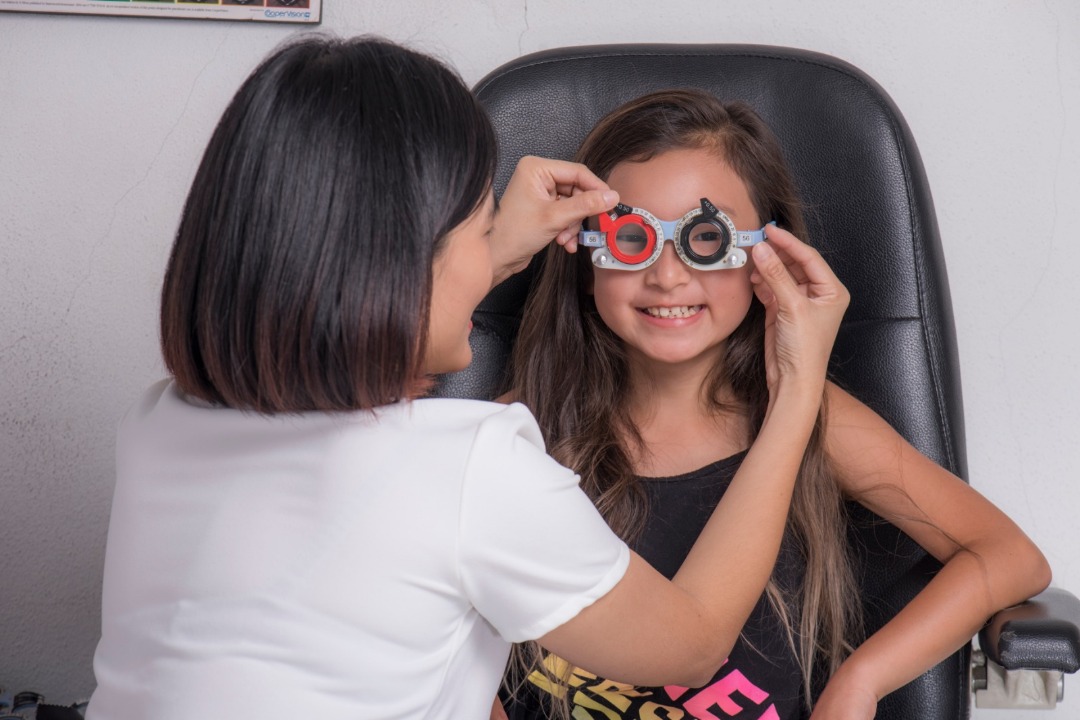
Case Study: Amanda was squinting her eyes in her class as her teacher noticed. She was notified to see an Optometrist.
Our Solutions: After a thorough eye examination, our professional Optometrist suggested several types of myopia control methods, from Ortho-K to ophthalmic lenses. She decided to use blue light protection lenses with Crispin Bees eyewear. It’s a flexible and lightweight frame for children.
Amanda now can see clearly even if she rotates to the back of the class. The teacher mentioned that she now has increased focus in class, improved grades and no more squinting to see clearly.
We carry an array of children’s eyewear that best suits their lifestyle, age and style! If you are looking for durable and flexible eyewear for kids that are able to withstand the vigorous twists of your child, look no further. To choose the best eyewear for your children is extremely crucial as we have tested them, used them and experimented with them.
The brands we carry are Tomato Kids, Crispin Bees, Zeiss Kids, RYAN ADDA Kids, Zoobug, Craftsman and so many more.
No matter how old your children are, with the help of our friendly Optometrists at Malaya Optical, you will definitely find the right pair that is able to cater to your child’s every possible needs.
Check out these cute super heroes wearing children’s eyewear from Malaya Optical. With 20-20 vision, these kids are saving the world by combating myopia one myopic child at a time.
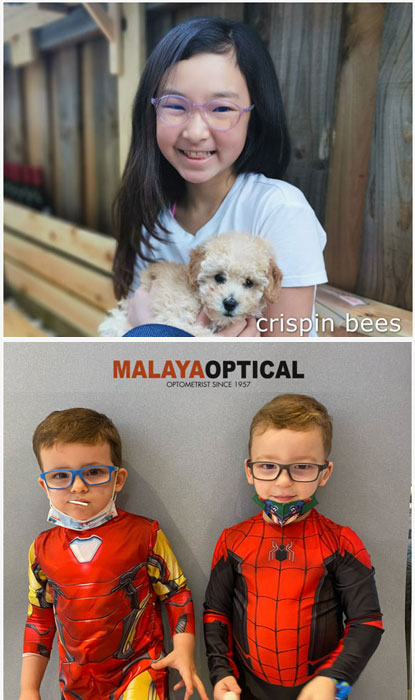
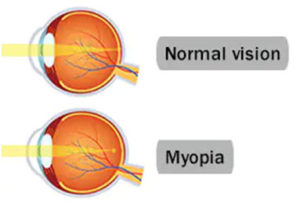 Myopia: Nearsightedness, the ability to see closer objects more clearly than distant objects. Myopia can be caused by an elongation of the eyeball or by any condition that prevents light rays from focusing on the retina.
Myopia: Nearsightedness, the ability to see closer objects more clearly than distant objects. Myopia can be caused by an elongation of the eyeball or by any condition that prevents light rays from focusing on the retina.
Myopia has become an epidemic that is impossible to ignore. According to a study published in the Journal of Ophthalmology, it is predicted that half the world’s population will be myopic by 2050, with up to 1/5 of them at a significantly increased risk of blindness if current rates continue.
Degrees of Myopia
Myopia is generally classified according to the degree of myopia, that is the power of the prescription lens required to correct the blurred vision, measured in dioptres (D).
Low myopia: -1.00 to -3.00
Moderate myopia: -3.00 to -6.00
High myopia: -6.00 and above
According to World Health Organization (WHO), the definition of high myopia is “a condition in which the spherical equivalent objective refractive error is ≤–5.00 D in either eye”.
Risks of Myopia
Are you and your husband both wearing glasses? What are the risks for your child to develop high myopia?
A normal eye length is 22 to 24 mm. The risk for the child to suffer from vision impairment when they grow older is high if the eyeball grows longer than 26 mm.
Myopia Control is about slowing down this excessive eye growth to the ideal normal rate of eye growth in childhood.
The table below shows the risks of eye diseases according to the degree of myopia when your child ages.
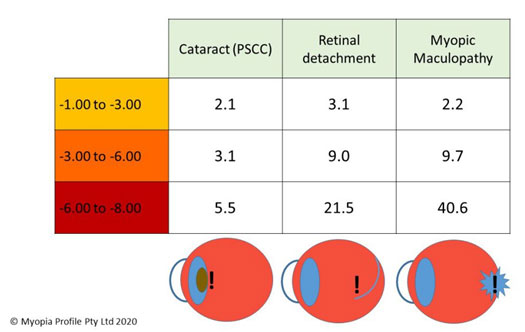
Squinting when watching TV, whiteboard at school
Sitting in close proximity to the TV/computer screen/books
Needing to sit in front of the classroom to see clearly
Seems disinterest in doing homework / sports
Yes, amongst other factors as well. Eg: lifestyle and reading habit
As soon as possible.
The core of visual hygiene is the 20-20-20 rule. For every 20 minutes of near activity, we should take a 20 second break and look at objects 20 feet away.
To completely stop the progression is pretty much impossible, especially if the child is still growing. We can control the progression of the myopia and slow it down.
Zeiss came up with 60% – find link
Yes, it does. Blue light protection lenses help to filter out the harmful blue light from entering your eyes.
Read more about OrthoK here
We cannot prevent myopia from happening, but we can control the progression of it with good visual hygiene together with one of the myopia control methods.
Yes, depending also on the prescription.
Eye rubbing is mostly associated with astigmatism, but in some instances can have an effect on myopia as well.
Myopia is not a dangerous vision condition, but it does increase the risk of your child to develop serious vision later in life. Eye diseases associated with high myopia include glaucoma, cataract, retinal detachment and myopic macular degeneration.



 For most people with myopia, eyeglasses are the primary choice for correction.
For most people with myopia, eyeglasses are the primary choice for correction. Another option for treating myopia is orthokeratology (ortho-k). Ortho-K is a specially designed rigid gas permeable lenses that gradually reshape the curvature of your cornea. The lenses place a gentle pressure on the cornea to flatten it. Hence, this changes the way light enters the eye, focusing the image onto the retina. This specialty contact lens are worn during sleeping time, and are removed in the morning to have clear vision without spectacles.
Another option for treating myopia is orthokeratology (ortho-k). Ortho-K is a specially designed rigid gas permeable lenses that gradually reshape the curvature of your cornea. The lenses place a gentle pressure on the cornea to flatten it. Hence, this changes the way light enters the eye, focusing the image onto the retina. This specialty contact lens are worn during sleeping time, and are removed in the morning to have clear vision without spectacles.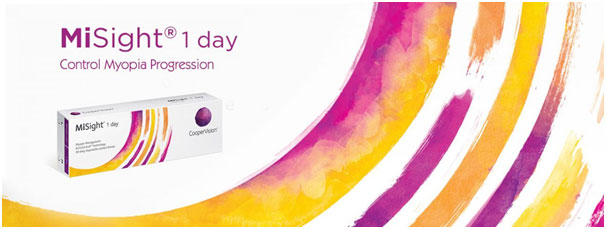
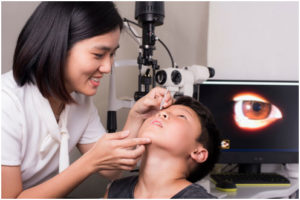 Atropine is an antimuscarinic agent that causes pupil dilation and loss of accommodation. According to studies, atropine has been found to be the most efficacious methods in slowing down the progression of myopia. The associated symptoms of photophobia and nearvision difficulties vary, as expected, with concentration. With any topically applied drug, a risk of systemic ab-sorption exists. Therefore, to use Atropine, your child has to be closely monitored by an Ophthalmologist
Atropine is an antimuscarinic agent that causes pupil dilation and loss of accommodation. According to studies, atropine has been found to be the most efficacious methods in slowing down the progression of myopia. The associated symptoms of photophobia and nearvision difficulties vary, as expected, with concentration. With any topically applied drug, a risk of systemic ab-sorption exists. Therefore, to use Atropine, your child has to be closely monitored by an Ophthalmologist

